Companies continue to develop more advanced riserless systems and ancillary technologies to bring down the high cost of subsea well interventions and improve efficiency and safety of operations.
Jeanne M. Perdue, Contributing Editor
There are about 4,000 subsea wells producing oil and gas around the world, and with many now over a decade old, intervention is crucial to maintain production volumes. However, subsea well intervention is a time-consuming, costly activity, with heavy rig costs running up to $1 million per day. Several companies have been developing more cost-effective workovers, downhole completion equipment and P&As of subsea wells in various water depths. Here are the latest innovations from Expro, FMC Technologies, Superior Energy Services, Blue Ocean, Lewis and others, including some new underwater technologies to make subsea operations easier.
EXPRO’S SYSTEM
After initiating discussions with a number of major operators in 2002, Expro began a riserless subsea intervention R&D program in 2003 with partial funding from three major oil companies. A feasibility study was completed in 2004, followed by the design and construction of key components at several locations in Scotland, and now the AX-S system is scheduled for completion by February 2010. The first field test is scheduled to take place in a Norwegian fjord in June 2010 before the system is installed on a North Sea well.
The new system (Fig. 1) is 33.5 m tall, weighs 220 tonnes and is rated for operations at up to 3,000 m of water depth. It is deployed onto a subsea tree with an active heave-compensated fiber winch from a monohull vessel, and is remotely controlled from the surface like an ROV. The system has an integrated set of subsea pressure-contained packages comprising well control and wireline tools, a wireline winch and fluid injection functions.
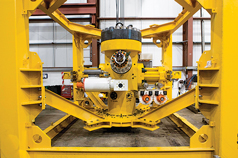 |
|
Fig. 1. Expro’s AX-S well control package in final assembly.
|
|
The well control package is a dual safety barrier containing industry-proven 7⅜-in. shear seal and gate valves. If any safety issues arise, the operator has time to identify the problem, because the system is a fully enclosed pressure housing with no dynamic seals between the wellbore and the surrounding environment.
Positioned directly above the well control package is the tool storage package, which contains eight tool pockets located around the inner circumference of the package. The tools are swapped on the seabed, and do not require pressure testing after each tool change because they are held in a pressure-retained housing. The pressure housing virtually eliminates hydrocarbon leaks into the seawater and water encroachment into the well.
The tools are run in the well by the wireline winch package. The winch has 25,000 ft of monoconductor that conveys the various intervention tools into the well. The fluid management package, which is the final subsea section, can deploy glycol fluid into the system to flush out hydrocarbons, which are then circulated back into the well or subsea production system. Depending on the specific needs, seawater can be mixed with the fluid in variable ratios.
A control cabin on the vessel has a computer interface that is used to instruct the various packages on a fully automated basis. All the hydraulic power is generated in the seafloor system, so there is no requirement for a hydraulic line to the surface. To ensure safe and effective operations, video cameras and an ROV are an integral part of the system.
Expro, Deep Tek Ltd. and Parkburn have developed a fiber rope umbilical bundle and handling system for deployment of the system. Three individual umbilicals are helically wrapped around a main fiber rope for greater strength. The rope is buoyant in water, so it adds no extra deployment weight. This allows a smaller handling system and deployment vessel to be used.
“Having 3,000 m of traditional wire rope would require the handling system to be more than double the size at 190 tonnes,” said Gerry Rideout, AX-S sales and marketing director for Expro. Asked to describe the benefits of the new system, Rideout said: “When comparing with rig-based interventions, the high operating cost and limited availability means that one operator in the Gulf of Mexico has budgeted about $35 million for a single wireline intervention. Using the AX-S system would dramatically reduce these costs.”
FMC TECHNOLOGIES
FMC Technologies began the design and manufacturing of the first-generation Riserless Light Well Intervention (RLWI) system in 2000. It was used on Prosafe’s Dynamically Positioned (DP) rig Regalia in 2003 for three successful intervention operations in 140–300 m of water.
In 2005, FMC entered into the North Sea Alliance with Island Offshore and Aker Well Services to operate three purpose-built monohull vessels for subsea intervention. The Island Frontier conducted its first well intervention for Chevron UK in April 2005, followed by two well operations for Nexen UK later that year. In 2006, the Alliance won a long-term contact (6+3 years) with Statoil. Since then, the Island Frontier has carried out 30 well interventions in 140–400-m waters, including scale milling, gauging and logging operations, plug setting and re-perforations using FMC’s RLWI technology, Fig. 2.
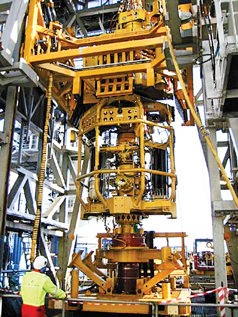 |
|
Fig. 2. First-generation RLWI hardware aboard the Island Frontier. From top to bottom, components shown are the lower lubricator package, the lower intervention package and the running tool for the Christmas tree.
|
|
The experience with the first-generation RLWI system showed good operational regularity and better than expected utilization in winter months. It achieved the objectives of reduced watercut and increased production rates. However, the complex hydraulic system was difficult to reconfigure between wells, and there was limited flexibility for contingency operations. The biggest problem was in handling the umbilicals, which were exposed to far heavier wear than they were designed to handle.
To improve on the original design, FMC developed the second-generation RLWI Mark II (Fig. 3), which switched from a multi-hose hydraulic umbilical to a smaller, electric, ROV-style umbilical cable that can be disconnected quickly and safely without ROV assistance and stands up to rigorous heave compensation winches. Engineers also reduced the weight and drag area in the upper stack to increase the operational weather window. Reconfiguration between wells and/or tasks is now much easier, and there is an improved interface to existing trees and the fully redundant control systems.
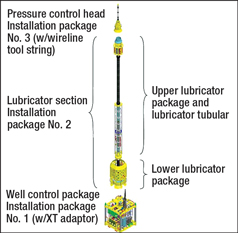 |
|
Fig. 3. FMC’s second-generation RLWI Mark II.
|
|
The second-generation RLWI system was installed on a second intervention vessel, the Island Wellserver (Fig. 4), which has been contracted by StatoilHydro for four years of work in the North Sea beginning in March 2009. “There has been a tremendous improvement in uptime,” said Brian Skeels, director of Emerging Technology at FMC. “With its 600-m water depth capability and better line handling, it’s perfect for the North Sea. You can be in and out of the well in seven days, tops.”
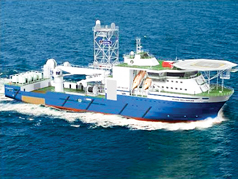 |
|
Fig. 4. The Island Wellserver has been contracted by StatoilHydro for four years of work in the North Sea.
|
|
The North Sea Alliance was also awarded a three-year subsea intervention contract with BP for West of Shetland, starting May 2009. A third, monohull intervention vessel with a moonpool, the Island Constructor (Fig. 5), was outfitted with a second RLWI Mark II system and is being shared 50/50 between BP and StatoilHydro. This past summer, the vessel did an intervention job on BP-operated Schiehallion Field at a water depth of 401 m, in challenging sea currents of up to 2.5 knots. There, the team set a new water-depth world record for subsea riserless wireline intervention from a ship.
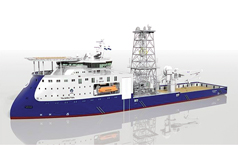 |
|
Fig. 5. The Island Constructor, outfitted with an RLWI Mark II, is being shared 50/50 between BP and StatoilHydro.
|
|
FMC’s Skeels sees the subsea intervention market increasing quickly in the near future. Workovers are generally not needed until a well is about five years old, and after that operators usually need to work over 10–20% of their wells each year. Skeels analyzed the global market for the next five years (Table 1) and determined that the number of RLWI vessels could double by 2014. “If we can get operators to sign up for rig days, the industry will build the new RLWI rigs. Once they’re built, it’ll take less than a month to deploy to a job,” he said at the 2009 SPE Annual Technical Conference & Exhibition in New Orleans. “The engineering is pretty much there; it just takes time to build and deploy and get the boat outfitted and commissioned. Global demand should bust loose in the next three years, populating the Gulf of Mexico, Brazil and West Africa.”
| TABLE 1. Riserless light well intervention market, five-year projection |
 |
SUPERIOR’S SYSTEM
The Superior Subsea Intervention System (SSIS) is a 31⁄16-in., full-bore, dual BOP system with hydraulic controls that can be used for subsea P&A in water depths up to 3,000 ft and live well interventions in up to 10,000-psi working pressures. It can also be used for perforation, production logging, sliding sleeves and changing out trees on subsea wells. The new sysem does not require a boat with a moonpool, as it can be run over the side of the boat, Fig. 6.
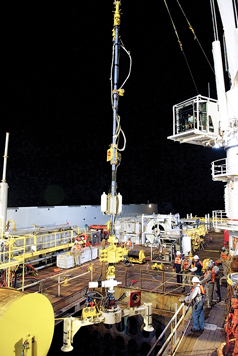 |
|
Fig. 6. Superior Energy Services’ SSIS can be lowered over the side of the vessel or through a moonpool, as shown.
|
|
The new system has been used successfully for 35 different jobs in the Gulf of Mexico, said Senior Project Engineer David Law. These jobs included zone shifts, BHP surveys, well diagnostics, tree exchanges, P&A, post-hurricane inspection, and setting bridge plugs and cement. In the near future, Superior is looking toward West Africa, with a possible 40-well project for a major operator in the offing. In Equatorial Guinea, Law said, there is high well density, so a four-point mooring vessel will interfere with the crowded infrastructure, and the 600-ft depths are too deep for a jackup. He said this would make a riserless option like the SSIS ideal, but there is a certain “drilling mentality” in the region that must be overcome by a paradigm change before riserless intervention can be widely accepted in West Africa.
“The innovation part of our SSIS is just pushing the envelope of proven technologies,” Law said. “It sounds simple; it is simple. You just have to have all of your toys in one box.”
Law offered some tips on selecting the right wells for riserless intervention. First, rule out horizontal wells. “You can’t push a limp rope uphill,” he said. Second, the well should be free of obstructions like wax buildup and fish items, and you should be able to run slickline or electric line in it. Third, having the right vessel and crew can make a big difference. Whether the boat requires four-point anchors or dynamic positioning, divers or ROVs, it may be worthwhile to pay $120,000 per day rather than $60,000 per day because “the boat makes the job.” Fourth, make sure there is a dual circulating reel and an installation/workover control system, which may have limited availability. But most of all, do the proper planning. “For an average week of work, plan to do one month of planning beforehand,” he recommended. “Cover every step in detail with the actual guys who will be doing the work. Communication makes or breaks a job.”
Law emphasized that you don’t have to wait for rig availability to start planning a subsea P&A. If you orchestrate properly, you can run three wells on one job, and such a campaign approach can cut the cost of each well to one-third of what the price would be if done individually.
BLUE OCEAN’S THIRD-GENERATION
The massive damage done to Gulf of Mexico wells by Hurricanes Katrina and Rita in 2005 was the inspiration for a new company, Blue Ocean Technologies, to develop a way to perform rigless and riserless interventions. Because of the inability to get a rig into the debris field, they had to figure out how to carry out P&A operations without a rig or riser. The US Minerals Management Service (MMS) estimates that decommissioning damaged wells costs 10 times more than routine decommissioning.
Blue Ocean worked with Halliburton and recompletion specialists Supreme Service & Specialty to devise the Interchangeable Riserless Intervention System (IRIS). After several system upgrades, the current, third-generation, version of IRIS includes ROV operability and increased intervention depth. Halliburton provided a subsea injector that places coiled tubing in a well without using a riser. The injector has been modified to function subsea, with new seals and fittings to handle the pressure differential. Rated to 3,000 m and 10,000 psi, the system can be deployed from a DP2-class dynamically positioned vessel with a knuckleboom crane, either through a moonpool or over the side and can begin work quickly by unspooling once the vessel arrives on site.
“It’s a simple system, like surface equipment that we use on a day-in, day-out basis,” said Perry Courville, Halliburton’s group manager for coiled tubing and hydraulic workover well intervention. “We don’t have to run a riser. We don’t have to run anchors. We can work immediately.”
The 1,500-m circulation umbilical with 1.5-in.-ID lines was supplied by JDR Cable Systems. The umbilical is self-supporting for rigless, riserless, open-water applications. An encapsulated braid supports the weight of both the umbilical and its termination assembly.
Supreme Service & Specialty adapted its recompletion system for subsea use. Its stack-pack recompletion system can be placed in a cased hole through a short subsea lubricator, run in small sections and assembled as it is installed. IRIS can be used for a range of tasks including P&A, sliding sleeve intervention, sand washouts, acid stimulations plus well diagnostics, intervention, completions and remediation.
BISON SUBSEA INTERVENTION BASE
Researchers at the Norwegian University of Science and Technology (NTNU) in Trondheim have developed a novel idea for an underwater conveyance for subsea intervention in deep or Arctic fields. The BISON is a heavy intervention submarine now under development for carrying out subsea tasks such as transportation and lifting without the use of surface support vessels. It is an autonomous unit with an energy source capable of providing the power required for such interventions. The energy module, mounted externally to the pressure hulls, is detachable and can supply 2 MW of electrical output.
The twin-hulled, catamaran-type submarine (Fig. 7) has two pressure hulls linked together by bracings, which allow the transit of personnel from one to the other as well as technical links. This degree of redundancy is a major design safety feature and also provides exceptional cargo and work space, and stability for work on the seafloor.
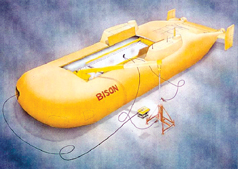 |
|
Fig. 7. NTNU’s BISON is a twin-hulled, catamaran-type autonomous submarine.
|
|
The submarine has been designed to carry out all transit and intervention operations submerged from the base of departure to the base of return. It does not require any support vessel for its operations, except for the installation of large and heavy structures (heavier than 100 tons) such as subsea templates. The submarine can use existing tools, systems and procedures and does not require any special specifications for existing or future subsea installations. Independence with respect to surface conditions and proximity to the worksite are distinct advantages of this concept with regard to operational safety and reduction of overall job duration (due to the absence of guide lines), more efficient deployment of ROVs and safer diver work conditions.
To date, feasibility studies have been conducted by NTNU covering 3D positioning capability, stability on the seabed, lifting operations, ROV deployment and lock-out of divers. According to Professor Maurice F. White of NTNU’s Department of Marine Technology, additional design studies will be carried out and a project group established to further develop the concept. Main activities will be:
• Detailed study of hull specifications
• Study of equipment arrangement
• Power and propulsion systems design
• Establishment of a users’ development advisory group for techno-economic studies.
Interested advisors may contact White at NNTU.
LEWIS’ EDP AND SLIC
Aberdeen-based Lewis Ltd., an acronym for Lightweight Economical Well Intervention Systems, has developed and qualified a new Emergency Disconnect Package (EDP) for rigid risers that has no maximum release angle, which makes it much safer and increases the maximum vessel operating circles for subsea intervention operations. Traditional EDPs employ a female cylinder over a male mandrel, which limits the disconnect angle. Lewis redesigned the connector with a two-stage locking mechanism and face-to-face connection for high-speed, high-angle release, and a patent on the technology is pending.
When the technology was tested in a 7⅜-in.-bore, 10,000-psi configuration under maximum bending load, a complete release was consistently achieved in just 3 s. The EDP was then reconnected and successfully pressure tested to full working pressure.
The first Lewis EDP was sold to Helix Well Ops for deployment from its Well Enhancer vessel as a key element of its new coiled tubing riser system. Further inquiries have been received for EDPs ranging from 4½ in. to 21 in., all of which Lewis has confirmed are possible future developments.
Lewis also developed the Stackable, Lightweight Intervention Connector, or SLIC, which extends the lubricator section of a riserless intervention system. This invention enables recovery of a dropped wireline tool string from the same vessel using the same riserless intervention system, which was not possible previously.
The SLIC interfaces with Lewis’ slickline control head, e-line control head, test and lift tool, and riser extension tool, Fig. 8. Safety has been ensured by separating all moving and hydraulic parts from exposure to wellbore fluids and pressure. Also, to minimize damage to sealing surfaces, each alignment, lockdown and stabbing function has been isolated so each step can be confirmed before starting another. The SLIC can now be used for coiled tubing and light drilling riser connectors or as a pressure control head for riserless interventions.
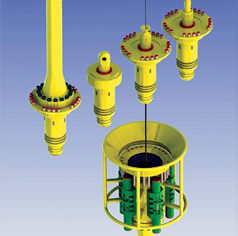 |
|
Fig. 8. The Stackable, Lightweight Intervention Connector (SLIC) from Lewis extends the lubricator section of a riserless intervention system.
|
|
SUBSEA 7’S HOT TAP TECHNOLOGY
Subsea 7 announced that following three years of development, testing and qualification, its new subsea hot tap technology, Subsea Grouted Tee (SSGT), has successfully completed offshore trials in the North Sea. The trials involved mobilization of a subsea grout mixing and injection unit, complete with test tee assemblies, on Subsea 7’s Seven Pelican dive support vessel. The skid-mounted mixing unit, developed to enhance diver-based hot tapping operations, allows the SSGT technology to be utilized in deep water, where pumping from the surface could be challenging.
During the trials, the mixing unit was deployed to the seabed, where divers carried out the installation and hookup operations, Fig. 9. After grout injection into a test tee assembly followed by a 24-hour grout curing period, the unit was recovered to the vessel, where it passed the grout quality test.
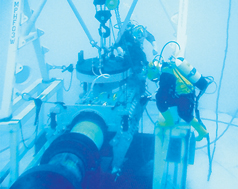 |
|
Fig. 9. Divers install the Subsea Grouted Tee mixing unit during trials.
|
|
“Subsea 7 has developed the capability to deliver this technology over the past three years because we believe it offers a safer and more cost-effective solution to traditional hot-tap intervention methods,” said Global Technology Manager John Mair. “The successful completion of the offshore tests further demonstrated the benefit and quality of mixing the grout on the seabed as opposed to pumping from the surface, providing further evidence that the technology can also be considered for deepwater, diverless applications.”
PHOTOSYNERGY’S ILLUMINATED UMBILICAL
A new energy-efficient LED technology for lighting fiber optic cables is being field tested by subsea divers at The Underwater Centre in Fort William, UK. Developed by PhotoSynergy, a company formed by the University of St. Andrews, the PSL-3000-M is an LED fiber illuminator that will supply a continuous line of light for 100 m under water. Designed to enhance subsea diver, ROV and tethered operations by offering a permanent light source for subsea navigation, the fiber illuminator cable is visible at depths up to 150 m and uses as little as 7 watts of power.
With the control box remaining on the surface or housed in a diving bell or ROV, there is no electrical current in the side-emitting fiber optic cable. The first industry trial will involve the fiber optic cable being attached to two diver umbilicals as they perform a diver rescue. Starting at 20 m of water depth, the cable will undergo full trials and depth testing using two of The Underwater Centre’s ROVs, Fig. 10.
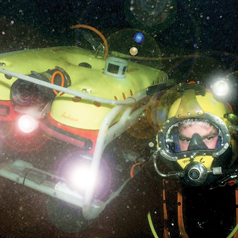 |
|
Fig. 10. The new illuminated umbilical will undergo sea trials and depth testing using two of The Underwater Centre’s ROVs.
|
|
Small and lightweight, the cable can operate on mains, direct current with battery backup or singular battery power. The core product produces a green light, which color is proven to be nearest the peak eye response for optimal visibility in low light or darkness. Operating mode is switchable between steady illumination or flashing on and off, the latter of which could be used as an emergency signal in the event of an incident. 
|













